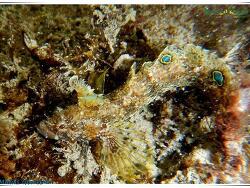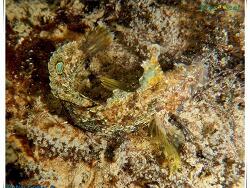Info
The holotype and paratypes of Paraclinus spectator were discovered in shallow rocky reefs around Rio de Janeiro, with material from the bay of Ilha Grande, Rio de Janeiro state (approx. 238S), south to Bombinhas beach, Santa Catarina state, being examined.
In the continental part of Ilha Grande Bay, Paraclinus spectator is the most common of all Paraclinus species, and in some parts of this bay, the blenny lives syntopically with Paraclinus arcanus and Paraclinus rubicundus.
The smallest adult female examined was measured at 3.7 cm in length.
Dark stripe from the rear edge of the eye socket to the rear tip of the upper jaw. Juveniles and females with distinct stripes on the body, dorsal and anal fins; dark stripes on the pelvic, pectoral and rear part of the caudal fin. Adult males with less pronounced to absent stripes, pelvic and pectoral fins uniformly dark gray. Some adult males have a dark longitudinal stripe along the rear part of the anal fin.
Paraclinus spectator was incorrectly identified as Paraclinus nigripinnis in Brazilian collections.
Synonym: Paraclinius spectator Guimarães & Bacellar, 2002 · unaccepted (misspelling)
Etymology:
The genus name “Paraclinus” comes from Greek, where “para” means “beside” and “klinein, kline” means “inclined and bed,” due to the four apophyses of the wedge-shaped bone.
Etymology:
The species name “spectator” was chosen because of its habit of observing divers and its surroundings.
In the continental part of Ilha Grande Bay, Paraclinus spectator is the most common of all Paraclinus species, and in some parts of this bay, the blenny lives syntopically with Paraclinus arcanus and Paraclinus rubicundus.
The smallest adult female examined was measured at 3.7 cm in length.
Dark stripe from the rear edge of the eye socket to the rear tip of the upper jaw. Juveniles and females with distinct stripes on the body, dorsal and anal fins; dark stripes on the pelvic, pectoral and rear part of the caudal fin. Adult males with less pronounced to absent stripes, pelvic and pectoral fins uniformly dark gray. Some adult males have a dark longitudinal stripe along the rear part of the anal fin.
Paraclinus spectator was incorrectly identified as Paraclinus nigripinnis in Brazilian collections.
Synonym: Paraclinius spectator Guimarães & Bacellar, 2002 · unaccepted (misspelling)
Etymology:
The genus name “Paraclinus” comes from Greek, where “para” means “beside” and “klinein, kline” means “inclined and bed,” due to the four apophyses of the wedge-shaped bone.
Etymology:
The species name “spectator” was chosen because of its habit of observing divers and its surroundings.







 Ricardo Zaluar Passos Guimarães, Brasilien
Ricardo Zaluar Passos Guimarães, Brasilien











